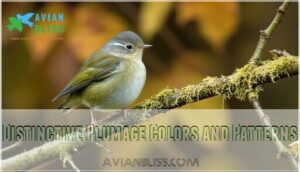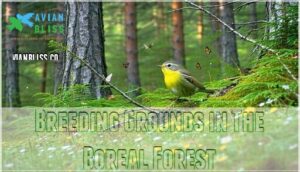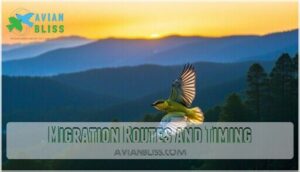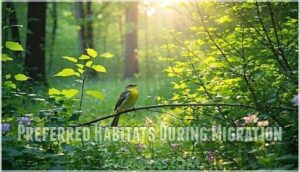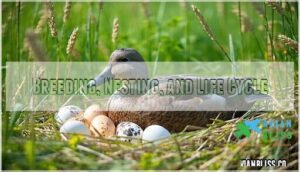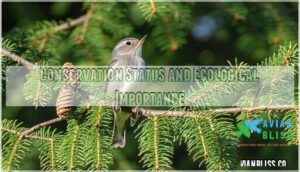This site is supported by our readers. We may earn a commission, at no cost to you, if you purchase through links.
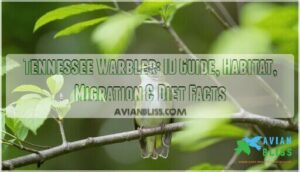
Don’t let the name fool you – these birds just pass through Tennessee during their epic journey from Canada’s boreal forests to Central America. They’re built for the long haul with stocky 4-5 inch frames and bills sharp enough to snag insects mid-flight.
Their seasonal menu shifts from caterpillar-heavy summer fare to winter fruits and nectar, proving they’re as adaptable as they are determined.
Table Of Contents
- Key Takeaways
- Tennessee Warbler Identification and Features
- Habitat, Range, and Migration Patterns
- Diet and Feeding Behavior
- Breeding, Nesting, and Life Cycle
- Conservation Status and Ecological Importance
- Frequently Asked Questions (FAQs)
- Where do Tennessee Warblers live?
- Why is it called a Tennessee warbler?
- What does a Tennessee warbler eat?
- What is the difference between a red eyed Vireo and a Tennessee warbler?
- How long do Tennessee Warblers live?
- Do Tennessee Warblers migrate? If so, where?
- What predators do Tennessee Warblers face?
- How do Tennessee Warblers cope with harsh weather?
- Are there any subspecies of Tennessee Warbler?
- How long do Tennessee Warblers typically live?
- Conclusion
Key Takeaways
- Tennessee warblers are long-distance migrants that breed in Canada’s boreal forests and winter in Central America, traveling up to 6,000 kilometers twice yearly despite their misleading name, which comes from a specimen collected in Tennessee in 1811.
- These birds are specialized insect hunters, with thin, sharp bills perfect for catching caterpillars, especially spruce budworm during outbreak years when they consume up to 90% caterpillars and can eat over 9,000 larvae per nest during the breeding season.
- You can identify them by their olive-green backs, clean white underparts, and distinctive thin white eyeline that cuts across their face, along with their small 4-5 inch stocky build and acrobatic feeding behavior of hanging upside down from branches.
- They play a crucial role as natural pest controllers in forest ecosystems, helping maintain ecological balance by consuming massive quantities of insects that could damage trees, while their stable population of 110 million birds indicates a healthy conservation status despite climate change threats.
Tennessee Warbler Identification and Features
Spotting a Tennessee Warbler starts with noting its small, stocky build and razor-sharp bill that’s noticeably thinner than similar birds like vireos.
You’ll recognize this little traveler by its olive-green back, clean white underparts, and the thin white eyeline that cuts across its face like a delicate brushstroke.
Size, Shape, and Measurements
When you spot a Tennessee Warbler, you’re looking at a bird that’s built like a tiny powerhouse—compact and sturdy, yet surprisingly nimble for its sparrow-sized frame.
These warblers measure just 4-5 inches long with a wingspan of 7-8 inches. Their short tail and thin, sharply pointed beak make them perfect for picking insects from foliage.
Notice how their head structure appears proportionally large for their body size.
Distinctive Plumage Colors and Patterns
The Tennessee Warbler’s subtle beauty lies in its understated color palette that shifts like autumn light through the seasons.
When you’re trying to spot one of these birds, here’s what to watch for:
- Olive-green back contrasting with white underparts
- Thin white eyeline creating a distinctive facial pattern
- Gray wash along the sides during breeding season
- Yellow-tinged juveniles showing brighter color morphs
- Clean appearance lacking wing bars or tail spots
Once you know these key features, picking out a Tennessee Warbler becomes much easier.
Differences Between Sexes and Similar Species
Distinguishing males from females requires careful observation of Sexual Dimorphism patterns. Breeding males show crisp gray heads and white eyebrows, while females appear duller with yellow-olive tones.
Species Comparison becomes essential when separating Tennessee Warblers from Orange-crowned Warblers – look for the white eyebrow and undertail coverts that distinguish your Tennessee Warbler. Warbler Identification experts note the thin, pointed bill differs from Philadelphia Vireos’ thicker bills.
Understanding the key differences in warbler species identification is essential for accurate classification.
Habitat, Range, and Migration Patterns
Tennessee Warblers travel thousands of miles each year, from Canada’s boreal forests where they breed to tropical wintering grounds in Central and South America.
You’ll spot these tireless migrants passing through Tennessee and other states twice yearly, following inland routes that connect their seasonal homes.
Breeding Grounds in The Boreal Forest
Deep in Canada’s vast boreal forest, where spruce and fir trees stretch endlessly toward the horizon, Tennessee Warblers find their true home. This breeding range spans thousands of miles across the northern wilderness, where dense coniferous stands create perfect nesting conditions. Here, these small songbirds thrive among the towering evergreens that define boreal forest ecology.
- Dense spruce and fir canopies provide excellent insect hunting grounds
- Forest floor dynamics create rich understory habitat for ground foraging
- Mixed coniferous stands offer diverse nesting site selection opportunities
- Boreal forest’s insect abundance meets warbler habitat requirements perfectly
- Avian community interactions flourish in these biodiverse northern ecosystems
Migration Routes and Timing
Twice yearly, Tennessee Warblers undertake remarkable journeys spanning up to 6,000 kilometers. Their migration patterns follow predictable routes and seasonal timing, revealing nature’s precision. The birds’ behavior during spruce budworm outbreaks is particularly striking, as their population responds numerically to these events.
| Migration Aspect | Spring | Fall |
|---|---|---|
| Peak Timing | Early May in U.S. | Mid-September peak |
| Route Focus | East of Appalachians | Slightly westward shift |
| Stopover Duration | 8 days average | 46 days (molt migrants) |
Flight speed averages reveal these warblers depart 30–45 minutes after sunset, with route variations showing Gulf of Mexico crossings in both seasons. Stopover sites become critical refueling stations where birds gain essential body mass. Adults migrate before juveniles, creating distinct waves of avian migration that ornithologists track across continents.
Wintering Habitats in Central and South America
When fall migration ends, these hardy warblers swap Canada’s snowy forests for the lush tropical landscapes of Central America and northern South America. You’ll find them in coffee plantations, forest edges, and dense canopy layers where insects stay abundant.
Unfortunately, habitat fragmentation threatens these wintering grounds, making conservation efforts vital for maintaining healthy migratory patterns across their range.
Preferred Habitats During Migration
You’ll spot Tennessee Warblers in surprisingly diverse places during their twice-yearly journeys, from towering oak groves to your own backyard shrubs. These adaptable birds use forest edges, urban landscapes, and coastal wetlands as essential stopover sites.
During Tennessee Warbler migration, they follow established migration routes through varied avian habitats, making bird migration patterns fascinating to observe.
Diet and Feeding Behavior
Tennessee Warblers shift their diet dramatically with the seasons, feeding nestlings up to 90% caterpillars during summer while switching to fruits and nectar in winter.
You’ll often spot them hanging upside down from branches, picking insects from dense foliage or joining mixed flocks during migration.
Primary Food Sources and Seasonal Changes
Like a feathered chameleon adapting to nature’s buffet, Tennessee Warblers shift their dining habits dramatically as seasons change. During the summer breeding season, their diet consists almost entirely of insect prey. Caterpillar diet dominates, especially spruce budworm during outbreak years. Winter brings fruit consumption and nectar sources to supplement their menu.
Tennessee Warbler Diet Essentials:
- Summer survival depends on caterpillars – up to 90% of nestling food comes from these protein-packed morsels
- Winter warmth found in sweet treats – berries and nectar provide essential energy for long migrations
- Seasonal foraging keeps families fed – beetles, spiders, and flies round out their insect buffet
- Nature’s timing creates abundance – warbler feeding behavior perfectly matches food availability cycles
Foraging Techniques and Adaptations
These tiny acrobats don’t just pick food off leaves—they’ve mastered the art of upside-down dining, dangling head-first from branches like feathered trapeze artists to snatch insects hiding on leaf undersides.
You’ll spot them threading through dense weed patches, their sharp bills perfectly designed for precision insect capture, while their agile tree foraging techniques let them exploit food sources other birds miss completely.
Role of Spruce Budworm in Diet
During budworm outbreaks, these warblers become specialized predators of spruce budworm larvae. Their diet shifts dramatically when budworm populations explode in 30-40 year cycles.
Here’s what makes Tennessee Warblers such effective budworm hunters:
- Single nests require up to 9,295 budworm larvae during 13-day nestling periods
- Budworm comprises 90% of nestling nutrition during outbreak years
- Breeding pairs consume 74,364 larvae per hectare each season
- Clutch sizes increase to 8 eggs when budworm are abundant
This ecological coupling makes Tennessee Warblers essential forest pest controllers.
Feeding in Mixed-Species Flocks
During migration, Tennessee Warblers don’t travel alone – they join bustling mixed-species flocks that move through the forest like a wave of feathers and song.
These flock dynamics create fascinating foraging strategies where birds learn from each other’s success. You’ll spot Tennessee Warblers picking up social learning cues about the best feeding spots while benefiting from predator avoidance through safety in numbers, despite some resource competition.
Breeding, Nesting, and Life Cycle
Tennessee Warblers breed in Canada’s boreal forests, where females build cup-shaped nests on the ground and lay 4-7 white eggs with brown markings.
The female performs all incubation duties for about 11-12 days, with breeding success often linked to spruce budworm outbreaks that provide abundant food for growing chicks.
Courtship and Mating Behaviors
When spring arrives in the boreal forest, male Tennessee Warblers transform from quiet migrants into passionate performers, singing their hearts out from the tallest treetops to claim territory and attract a mate.
When it comes to wooing a mate, male Tennessee Warblers pull out all the stops:
- Persistent territorial singing from dawn to dusk
- Wing-fluttering displays while approaching females
- Chase flights through dense canopy branches
- Food offering behaviors to potential partners
- Aggressive posturing toward competing males
This breeding season behavior helps establish pair bonding essential for successful reproduction.
Nest Construction and Egg Characteristics
Female Tennessee Warblers don’t win any awards for fancy architecture, but their ground-level nests get the job done with considerable efficiency.
These warbler nesting habits involve weaving grass and moss into cup-shaped structures. Each clutch contains 5-6 eggs white with brown markings, though clutch size variation depends on food availability.
Cowbird parasitism rarely affects these well-hidden nests.
Incubation and Parental Care
Once the eggs are laid, the female Tennessee Warbler takes on the full responsibility of keeping them warm for 11 to 12 days straight. During this incubation period, she rarely leaves the nest except for brief feeding breaks. The male doesn’t help with incubation but may bring food to his mate. These eggs, white with brown markings, face minimal egg parasitism from cowbirds, giving the young better chances for development and success.
Here’s what makes Tennessee Warbler incubation so fascinating:
- Solo Female Duty – Only the female undertakes incubation duties while males focus on territory defense
- Temperature Control – Consistent warmth is critical for proper nestling diet development inside the eggs
- Low Parasitism Risk – Tennessee warbler nesting habits protect against cowbird interference
- Brief Feeding Breaks – Females leave the nest just long enough to maintain their energy
- Parental Roles Shift – After hatching, both parents contribute to fledgling success through feeding
Factors Affecting Breeding Success
Food availability can make or break a Tennessee Warbler’s chance at raising a healthy brood. During spruce budworm outbreaks, females lay more eggs since caterpillars are plentiful. Climate change affects insect timing, creating mismatches between peak food and nesting periods. Nest predation and habitat quality also influence success rates greatly.
| Success Factor | Impact on Breeding |
|---|---|
| Food Availability | More eggs laid during insect outbreaks; poor food = fewer young survive |
| Nest Predation | High predation rates reduce fledgling success in fragmented habitats |
| Climate Change | Shifts insect emergence timing, affecting chick development and parental experience |
Conservation Status and Ecological Importance
Tennessee Warblers maintain stable populations across their vast North American range, earning them a “least concern” conservation status.
These small songbirds play an important role in forest ecosystems by controlling insect populations, especially during spruce budworm outbreaks when they can consume up to 90% of caterpillars in their diet.
Population Trends and Threats
Roughly 110 million Tennessee Warblers exist globally, but you’ll see big Population Fluctuations tied to spruce budworm outbreaks. Climate Change Impact threatens 58% of their summer range by 2080.
Habitat Loss Effects from logging and farm changes hurt both breeding and wintering grounds.
Pesticide Use during budworm control creates risks, while Migration Mortality from building collisions affects 1-3% annually.
Conservation Efforts and Habitat Protection
Protecting Tennessee Warblers isn’t just about saving one small bird—it’s about safeguarding entire forest ecosystems that countless species call home. Wildlife Conservation Efforts across North America focus on addressing key threats:
- Habitat Loss from deforestation and development in breeding grounds
- Climate Change shifting migration timing and food availability
- Pesticide Impact reducing insect prey populations
- Protected Areas expansion in boreal forests and wintering grounds
Citizen Science programs help track population trends, while Ornithological Research guides targeted Habitat protection strategies throughout their range.
Role in Forest Ecosystems
Think of Tennessee Warblers as nature’s pest control specialists, keeping forest ecosystems balanced by devouring countless insects that could otherwise damage trees. Their foraging habits create a ripple effect through nutrient cycling, while their pollination services and seed dispersal activities bolster ecosystem health across vast woodland areas.
| Ecosystem Role | Impact | Forest Benefit |
|---|---|---|
| Insect control | Consume 90% caterpillars | Protects tree health |
| Pollination services | Visit flowering plants | Promotes plant reproduction |
| Seed dispersal | Transport seeds while feeding | Increases plant diversity |
| Nutrient cycling | Deposit droppings across habitats | Enriches soil quality |
| Habitat preferences | Mixed-species flocks | Maintains biodiversity balance |
Ongoing Research and Monitoring
Scientists use cutting-edge tools to track Tennessee Warblers wherever they go. The MOTUS Wildlife Tracking System uses telemetry to follow their migration routes and see how many survive the journey. Meanwhile, banding stations like Powdermill gather detailed info on when and where these birds move throughout the year.
To get the big picture on population trends, researchers combine data from the official Breeding Bird Survey with thousands of sightings reported by birdwatchers through eBird.
Scientists also dig into how habitat changes and shifting climate patterns affect breeding success—especially during those boom-and-bust spruce budworm years that can make warbler populations swing wildly.
Frequently Asked Questions (FAQs)
Where do Tennessee Warblers live?
Like nomads following ancient pathways, Tennessee Warblers split their time between Canada’s boreal forests for breeding and Central-South America for winter.
Despite their name, they don’t actually live in Tennessee year-round—they just pass through during migration, visiting various forest habitats along the way.
Why is it called a Tennessee warbler?
Alexander Wilson collected the first specimen in Tennessee back in 1811, giving this warbler its misleading name. The bird doesn’t actually breed there—it just passes through during migration.
- Historical mix-up: Wilson’s specimen from Tennessee created a naming misnomer that stuck
- Migration route: Tennessee acts as a stopover, not a breeding ground for these warblers
- Boreal breeders: They actually nest in Canada’s forests, far from their Tennessee namesake
What does a Tennessee warbler eat?
Surprisingly tiny birds consume massive amounts of food daily. Tennessee warblers primarily eat insect prey like caterpillars, especially spruce budworm during outbreaks. Their warbler diet includes beetles, spiders, bees, and flies.
These foraging strategies shift seasonally—winter brings fruit consumption and nectar feeding from flowers.
What is the difference between a red eyed Vireo and a Tennessee warbler?
Red-eyed Vireos have thicker, heavier bills compared to Tennessee Warblers’ thin, sharply pointed beaks.
Tennessee Warblers are smaller with olive-green backs and white undersides, while vireos are larger with more sturdy builds and different plumage patterns.
How long do Tennessee Warblers live?
While no wildlife biologist has tracked one particular individual warbler from hatching to death, the oldest recorded Tennessee Warbler was 4 years, 7 months old. Most Tennessee Warbler characteristics suggest typical small songbird mortality rates affect their survival strategies.
Several factors influence how long these birds live:
- Environmental hazards during migration routes spanning thousands of miles
- Predation pressure from hawks, cats, and nest parasites throughout their range
- Food availability fluctuations, especially during spruce budworm outbreak cycles
Age records from bird identification studies indicate longevity studies remain limited for this Tennessee Warbler description.
Do Tennessee Warblers migrate? If so, where?
Yes, Tennessee Warblers migrate vast distances along major flyway routes. They breed in Canada’s boreal forests, then travel through Tennessee and other stopover sites to reach wintering grounds in Central and northern South America.
What predators do Tennessee Warblers face?
Multiple predators threaten Tennessee Warblers through hawk attacks from above and snake threats at ground level.
Nest predators include red squirrels, skunks, weasels, gray jays, martens, and garter snakes targeting eggs and nestlings, requiring constant predator avoidance behaviors.
How do Tennessee Warblers cope with harsh weather?
Small birds handle storms by sensing weather changes, taking shelter, and using their migration patterns to avoid extreme conditions. Tennessee warblers rely on their habitat flexibility and climate resilience.
Are there any subspecies of Tennessee Warbler?
Across North America, this seemingly uniform warbler species reveals surprising genetic variation beneath its drab exterior. Modern molecular phylogeny studies show the Tennessee Warbler maintains its taxonomic history as a single species without recognized subspecies.
Scientists studying these warblers have found something interesting:
- Genetic Variation exists across populations but remains below subspecies classification thresholds
- Molecular Phylogeny confirms monotypic status despite geographic breeding range
- Taxonomic History shows consistent single-species designation since Wilson’s 1811 description
This uniform subspecies classification distinguishes warblers from many wood-warbler relatives.
How long do Tennessee Warblers typically live?
Warbler Species usually live 2-3 years in the wild, though Longevity Studies show some reach 10 years utmost. Age Distribution and Mortality Rates vary markedly due to Lifespan Factors.
Conclusion
Imagine this: you’re standing in your backyard when a flash of olive-green catches your eye. That split-second sighting could be your gateway to understanding one of nature’s most exceptional travelers.
A flash of olive-green in your backyard could be your gateway to witnessing one of nature’s most extraordinary intercontinental journeys
The Tennessee warbler proves that small birds can accomplish impressive feats. These determined migrants connect vast ecosystems from Canada’s wilderness to Central America’s tropical forests.
By learning to identify their clean white underparts and distinctive eyeline, you’re not just spotting a bird—you’re witnessing an ancient journey that spans continents.
- https://www.allaboutbirds.org/guide/Tennessee_Warbler/maps-range
- https://naturecenter.org/wp-content/uploads/2022/03/3-Morris-et-al-2013.pdf
- https://animaldiversity.org/accounts/Vermivora_peregrina/
- https://extapps.dec.ny.gov/fs/programs/dfw/SWAP2025/Birds/Tennessee%20warbler%20SSA.pdf
- https://www.audubon.org/field-guide/bird/tennessee-warbler


